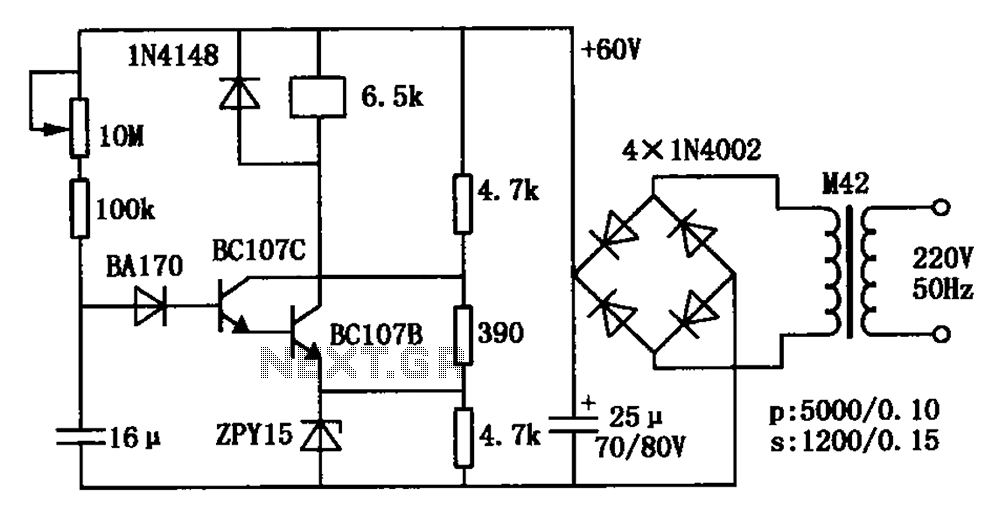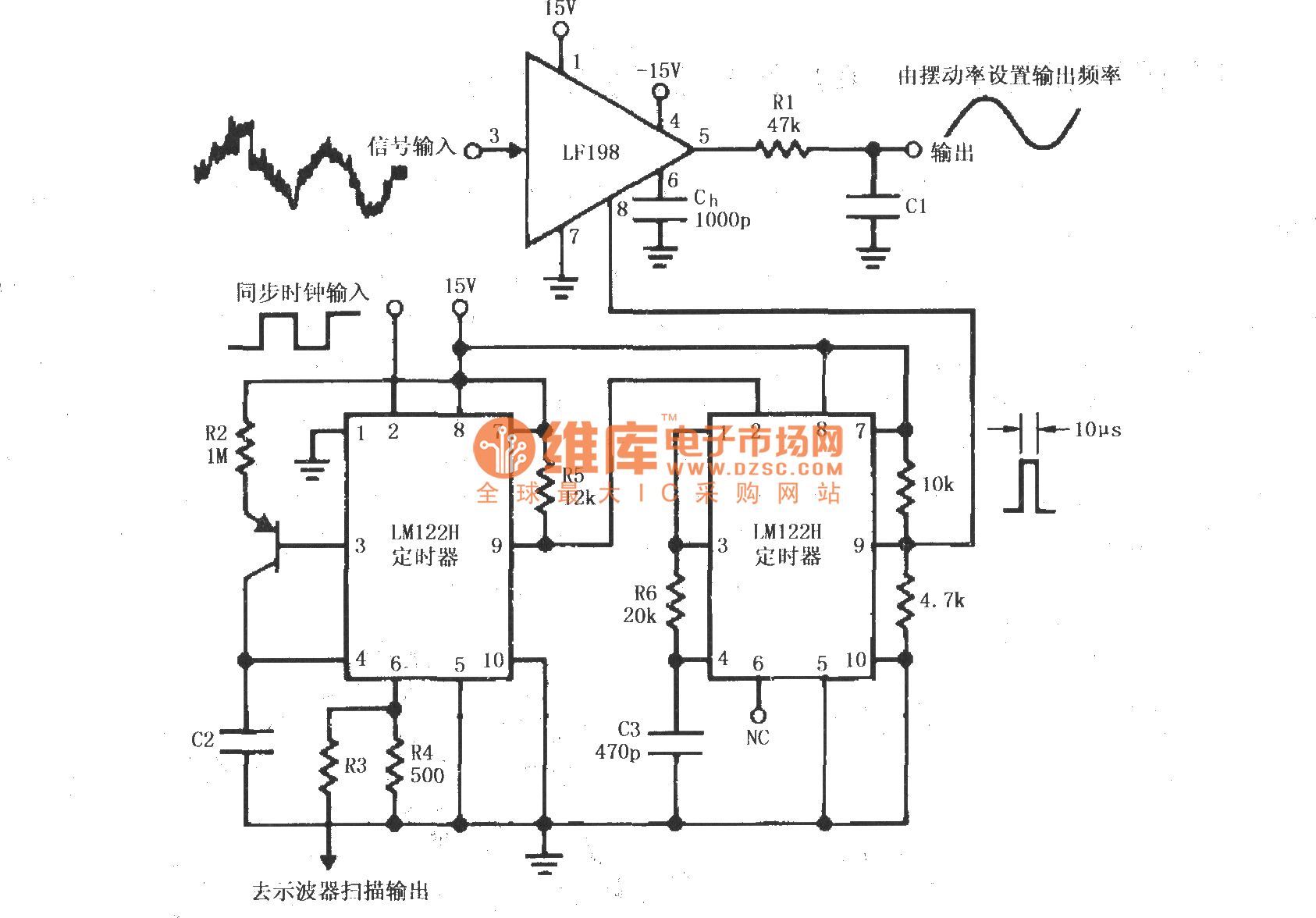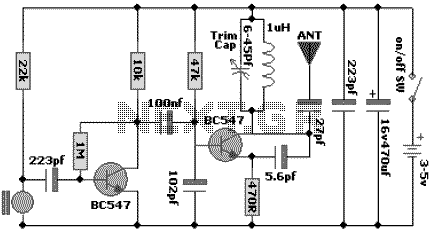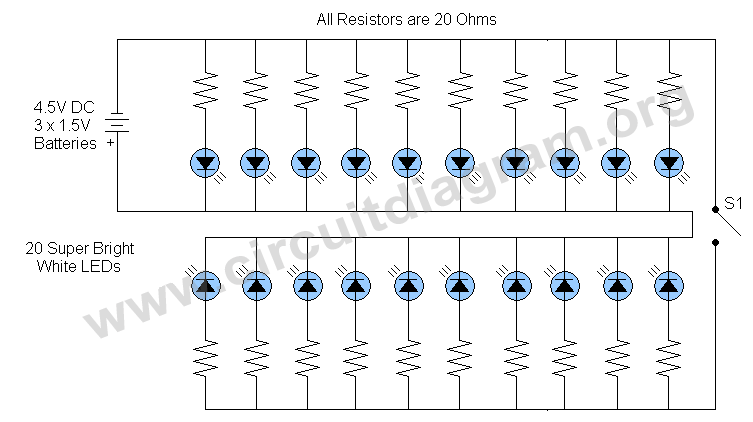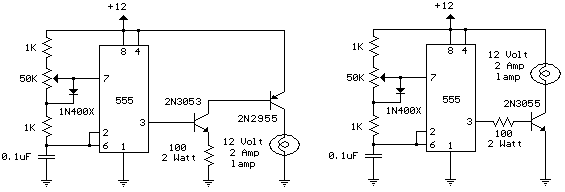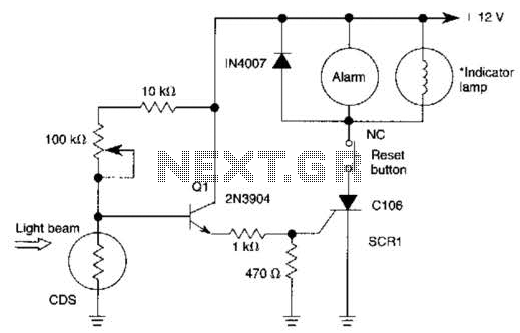
Dynamic Mic Preamplifier Circuit
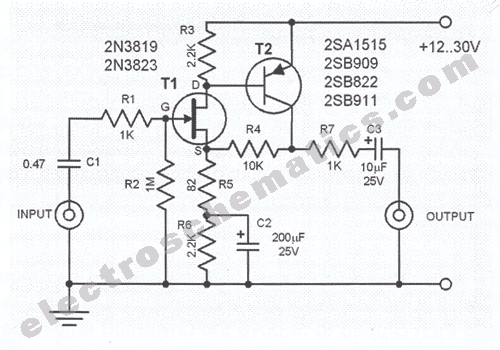
This microphone preamplifier utilizes the low-noise integrated circuit uA739. The circuit serves as an example of an effective preamplifier design for dynamic microphones. The integrated circuit contains two identical preamplifier circuits, with the second preamp functioning in the same manner for the second channel of a stereo microphone. The non-inverting input is biased at approximately 50% of the power supply voltage, with this bias voltage established by a voltage divider circuit consisting of resistors R1 and R4. The junction between R1 and R4 is shared between both channels. High-frequency noise signals from the microphone are filtered out by an RC circuit made up of resistor R3 and capacitor C4. Frequency compensation is achieved through the R7/C6 circuit, where the values of R7 and C6 are selected to prevent oscillation at an amplification level of 100. The input impedance of the circuit is about 47 kΩ, allowing for compatibility with standard dynamic microphones, which results in optimal performance. The output impedance is several hundred ohms, and the maximum peak-to-peak output voltage is slightly lower than the supplied power. The frequency response spans from 20 Hz to 20 kHz (-3 dB), with an upper cutoff frequency of 80 kHz when the low-pass filter is omitted from the circuit. The uA739 integrated circuit can be substituted with TBA231 or SN76131 without altering the external circuit configuration.
This microphone preamplifier circuit is designed to provide high-quality audio signal amplification for dynamic microphones. The uA739 is a dual operational amplifier that ensures low noise levels and high fidelity in audio applications. The circuit layout typically includes a power supply connection, where the voltage divider formed by R1 and R4 sets the appropriate biasing for the non-inverting inputs of both preamps. This biasing is crucial for maintaining the linearity and performance of the preamp, especially under varying input signal conditions.
The RC filter comprising R3 and C4 serves to attenuate any unwanted high-frequency signals that may be picked up by the microphone, ensuring that only the desired audio frequencies are amplified. This filtering is essential for maintaining audio clarity and preventing distortion from high-frequency noise. The inclusion of the R7/C6 frequency compensation network is vital for stabilizing the gain of the amplifier at higher frequencies, thereby preventing unwanted oscillations that could compromise audio quality.
The input impedance of 47 kΩ is particularly advantageous, as it allows for a wide range of dynamic microphones to be connected without significant loading effects, thus preserving the microphone's performance characteristics. The output impedance, measured in several hundred ohms, is suitable for interfacing with standard audio equipment, such as mixers or audio interfaces.
The frequency response of the preamp, extending from 20 Hz to 20 kHz, ensures that it captures the full range of audible frequencies, making it suitable for various audio applications, from music recording to broadcasting. The ability to remove the low-pass filter and achieve an upper cutoff frequency of 80 kHz provides additional flexibility for specialized applications that may require broader frequency handling.
In summary, this microphone preamplifier circuit exemplifies a robust and versatile design, capable of delivering high-quality audio amplification for dynamic microphones while maintaining low noise and high fidelity. The option to replace the uA739 with other compatible integrated circuits, such as the TBA231 or SN76131, further enhances the circuit's adaptability for different design requirements.This mic preamp uses the low noise IC uA739. The circuit is an example of how a good preamplifier can be designed for dynamic microphones. The IC houses two identical integrated preamp circuits. The second preamp is used in identical manner for the second channel of the stereo microphone. The non-inverting input is biased at about 50% of the power supply. This bias voltage is set by the voltage divider circuit R1 and R4. The point between R1 and R4 is used commonly for both channels. The unwanted HF signals coming from the microphone are filtered out by the RC-circuit composed of R3/C4. Frequency compensation is done by the R7/C6 circuit. The values of R7 and C6 were designed to avoid oscillation at the amplification level of 100. The input impedance is about 47K. This means that a normal dynamic microphone gets connected to a high impedance preamp which in turn produces good results.
The output impedance is about several hundred ohms. THe maximum peak-peak output voltage is about several volts lower than the supplied power. The frequency range is from 20Hz to 20KHz (-3dB). The upper cutoff frequency is 80KHz when the low-pass filter is removed from the circuit. The IC shown can be replaced with TBA231 or SN76131 without changind the external circuit. 🔗 External reference
This microphone preamplifier circuit is designed to provide high-quality audio signal amplification for dynamic microphones. The uA739 is a dual operational amplifier that ensures low noise levels and high fidelity in audio applications. The circuit layout typically includes a power supply connection, where the voltage divider formed by R1 and R4 sets the appropriate biasing for the non-inverting inputs of both preamps. This biasing is crucial for maintaining the linearity and performance of the preamp, especially under varying input signal conditions.
The RC filter comprising R3 and C4 serves to attenuate any unwanted high-frequency signals that may be picked up by the microphone, ensuring that only the desired audio frequencies are amplified. This filtering is essential for maintaining audio clarity and preventing distortion from high-frequency noise. The inclusion of the R7/C6 frequency compensation network is vital for stabilizing the gain of the amplifier at higher frequencies, thereby preventing unwanted oscillations that could compromise audio quality.
The input impedance of 47 kΩ is particularly advantageous, as it allows for a wide range of dynamic microphones to be connected without significant loading effects, thus preserving the microphone's performance characteristics. The output impedance, measured in several hundred ohms, is suitable for interfacing with standard audio equipment, such as mixers or audio interfaces.
The frequency response of the preamp, extending from 20 Hz to 20 kHz, ensures that it captures the full range of audible frequencies, making it suitable for various audio applications, from music recording to broadcasting. The ability to remove the low-pass filter and achieve an upper cutoff frequency of 80 kHz provides additional flexibility for specialized applications that may require broader frequency handling.
In summary, this microphone preamplifier circuit exemplifies a robust and versatile design, capable of delivering high-quality audio amplification for dynamic microphones while maintaining low noise and high fidelity. The option to replace the uA739 with other compatible integrated circuits, such as the TBA231 or SN76131, further enhances the circuit's adaptability for different design requirements.This mic preamp uses the low noise IC uA739. The circuit is an example of how a good preamplifier can be designed for dynamic microphones. The IC houses two identical integrated preamp circuits. The second preamp is used in identical manner for the second channel of the stereo microphone. The non-inverting input is biased at about 50% of the power supply. This bias voltage is set by the voltage divider circuit R1 and R4. The point between R1 and R4 is used commonly for both channels. The unwanted HF signals coming from the microphone are filtered out by the RC-circuit composed of R3/C4. Frequency compensation is done by the R7/C6 circuit. The values of R7 and C6 were designed to avoid oscillation at the amplification level of 100. The input impedance is about 47K. This means that a normal dynamic microphone gets connected to a high impedance preamp which in turn produces good results.
The output impedance is about several hundred ohms. THe maximum peak-peak output voltage is about several volts lower than the supplied power. The frequency range is from 20Hz to 20KHz (-3dB). The upper cutoff frequency is 80KHz when the low-pass filter is removed from the circuit. The IC shown can be replaced with TBA231 or SN76131 without changind the external circuit. 🔗 External reference
